Product Support
How to Access the AXM-WEB at Admin Level
1. AXM-WEB Web Login Interface
To view the AXM-WEB web interface an Ethernet connection is needed.
-
Open an internet browser and type in the IP address of the meter in the browser search bar and hit the Enter key. The meter’s web login page will display as followed:
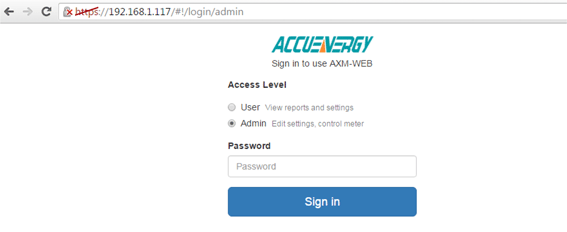
Figure 1
-
Login to the web page as ‘Admin’. The default password is ‘admin’.
Upon successfully logging in you will be redirected to the Dashboard where a brief report of data from the meter will display. The Dashboard will also display how long the AXM-WEB has been up and communicating.
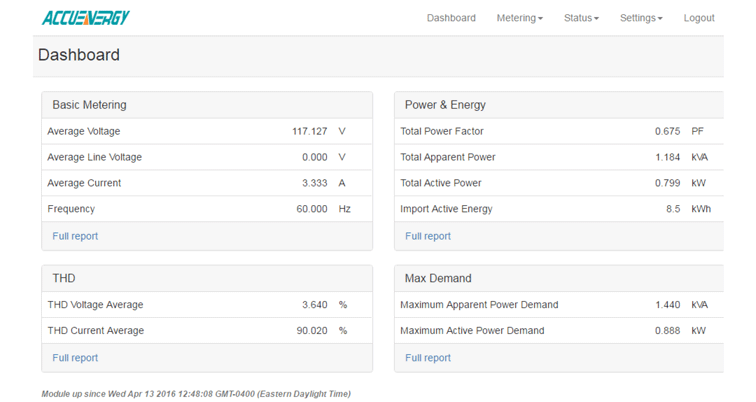
Figure 2
2. Metering Management
To view more data click on ‘Metering’. This will display a list of parameters that can be viewed from the AXM-WEB. Click on the sub-section that corresponds to the data you would like to view:
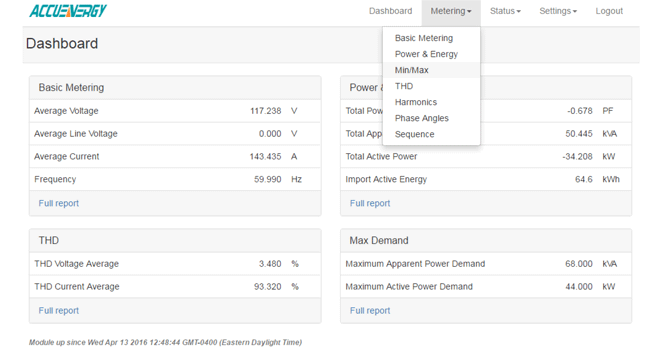
Figure 3
Basic Metering: This page will show the real-time readings such as voltage, current , power and etc.
Power & Energy: This page will show the energy readings such as the import energy, export energy, total energy as well as the demand readings.
Min/Max: This page shows the maximum and minimum statistics that the meter has recorded since the lifetime of the meter or from the last reset of the min/max statistics.
THD: This page will show the power quality data such as the THD, THFF, crest factor and etc. for both voltage and current.
Harmonics: This page will show the harmonics of the voltage and current waveform. It will display the harmonics of each phase in graphical and tabular format. Select between voltage and current to view their respective harmonics as well as between the 2nd-31st harmonics or 32nd-63rd.
Phase Angles: This page will show the phase angles of the voltage and current waveform.
Sequence: This page will show the positive, negative and zero components of the voltage and current waveform.
3. Status Management
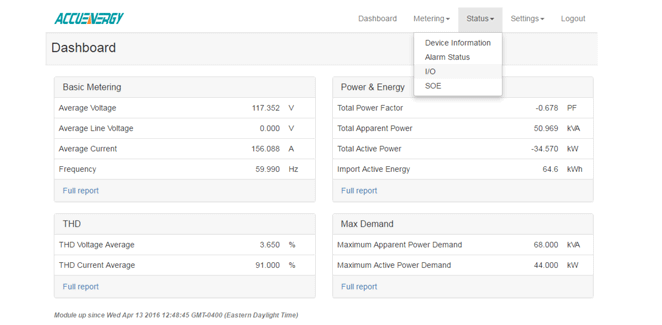
Figure 4
Device Information: This page will display meter information such as the model, serial number, firmware version and device address of the meter. It will also provide the serial number, firmware version, hardware version and MAC address of the AXM-WEB module.
Alarm Status: This page will display the alarm log of the meter. It will provide the status of up to 16 alarm events indicating the parameter, value and timestamp of the alarm event.
I/O: This page will show the status of the I/O Modules that are connected and their values. I.E. Relay Output status(on/off), DI status and etc.
SOE: This page shows the Sequence of Event log for the enabled I/O module with timestamps.
4. Settings Configuration
Basic meter settings can be configured through the web interface by clicking on the ‘Settings’ tab and selecting the configurations to change from the list that appears.
Note: After making any changes in the settings tab, the AXM-WEB must be rebooted through the web interface by going to the ‘Management’ page.
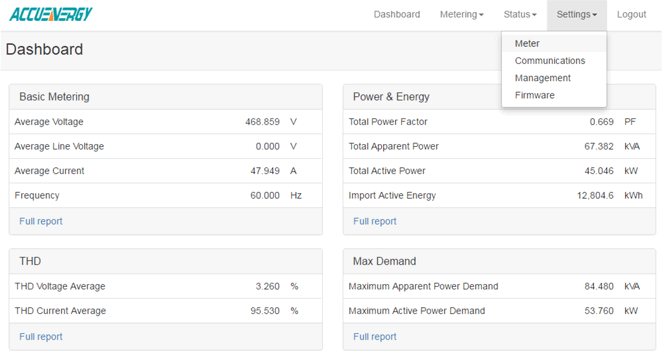
Figure 5
4a. Settings: Configure Voltage, Current, PT & CT ratios
To configure settings such as the voltage, current wiring as well as the PT and CT ratios, select ‘Meter’ from the ‘Settings’ tab.
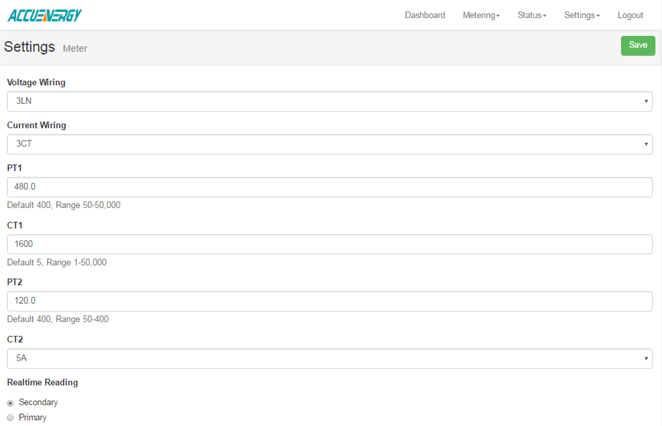
Figure 6
Voltage Wiring: Select how the meter’s voltage input terminal is wired by selecting a configuration from the drop down list. I.E. for a three phase three wire configuration without a neutral, select 3LL.
Current Wiring: Select the number of CT’s that are connected to the meter’s current input terminal by selecting a number from the drop down list.
PT1: Enter the rated input of the potential transformer that is connected to the meter. Possible range is from 50 to 50000V.
CT1: Enter the rated input of the current transformer that is used with the meter. Possible ranges for the CT1 is from 1 to 50000A.
PT2: Enter the rated output of the potential transformer. Possible range is from 50 to 400V.
CT2: Select the rated output of the current transformer from the drop down list. By default this setting is already configured.
Click ‘Save’ after changing any settings. The AXM-WEB will also need to be rebooted from the ‘Management’ page.
4b. Settings: Network Configuration
-
To configure settings related to the network select the ‘Communication’ option from the ‘Settings’ tab. The page you will be directed to is for configuring the meter’s network settings. Other settings can be configured by clicking on the corresponding tab such as emails, SNTP and HTTP/FTP Post.
-
You can change the configurations of your network parameters.
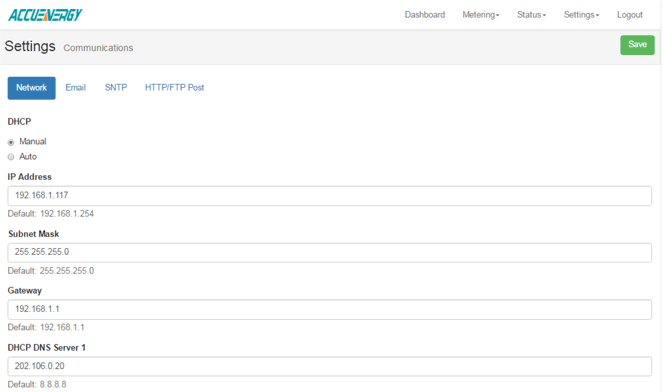
Figure 7
DHCP: Select ‘Manual’ to manually configure the IP address to access the meter. If set to ‘Manual’, you’ll also need to set the Subnet Mask and Gateway.
Select ‘Auto’ to have the meter assigned a IP address automatically. With this selection, the IP address, Subnet Mask and Gateway will also be automatically assigned.
Note: After changing DHCP to Auto, check the display of the meter to obtain the new IP address that was assigned.
IP Address: If the DHCP is configured to Manual, the IP address can be configured from this page.
Subnet Mask: If the DHCP is configured to Manual, the Subnet Mask can be configured from this page.
Gateway: If the DHCP is configured to Manual, the Gateway can be configured from this web page.
DHCP DNS Server 1:Enter the address of the DNS 1 server in this page.
DHCP DNS Server 2: Enter the address of the DNS 2 server in this page.
HTTPS Port: Enter the HTTPS port number of the meter. By default, this setting is configured to 443. The range can be from 6000 to 9999.
Modbus TCP Port: Enter the Modbus port number of the meter. By default, this setting is configured to 502. The range can be from 2000 to 5999.
Click ‘Save’ after changing any settings. The AXM-WEB will also need to be rebooted from the ‘Management’ page.
4c. Settings: Management Configuration
This page can be used to reset parameters such as the Demand, Energy, Max/Min, alarm records and etc as well as setting or changing the password for the access levels. This page is also where the AXM-WEB can be rebooted so that all changes can take effect.
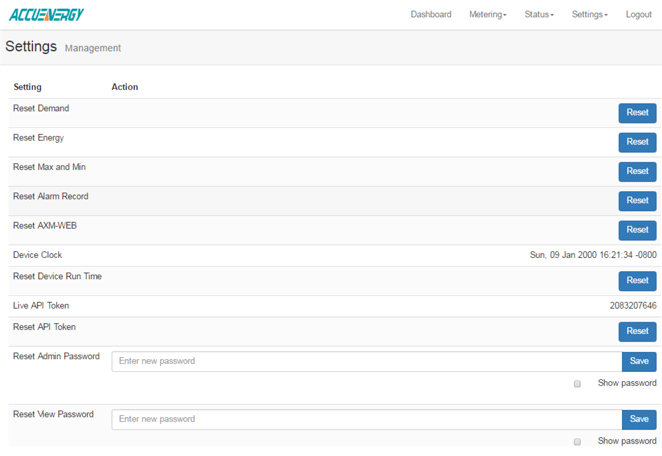
Figure 8
4d. Settings: Firmware Updates
This page is used for updating the firmware version on the AXM-WEB module. If you would like to update the firmware, please contact Technical Support with the current firmware version of the AXM-WEB module.
